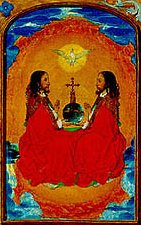Tell A Friend About This Site!


Some detractors claim that the early Christians copied the Trinity from surrounding pagan religions. Yet as the article The Trinity: An Explanation shows, the concept came from a careful reading and inspired interpretation of the Bible, which refers to three distinct Persons as "God" yet insists that there is but one God.
An Egyptian "Trinity"?
Before Christianity, no religion ever believed in a single Deity consisting of three persons. Detractors sometimes say that the Osirus-Isis-Horus family of ancient Egyptian mythology was a "model" for the Christian Trinity. Yet this is clearly a triad of distinct pagan deities, not a trinity in the Christian sense. The Egyptians never considered them to be three persons in one God, but as two separate gods and a goddess - among numerous other divinities such as Hathor, Ptah, Neith, Set, Nut, Geb, and Basht, to name a few. The highest deity in their pantheon was the sun god Ra, so they didn't even consider the Osirus-Isis-Horus triad to be supreme among the gods!
Triune Goddess?
Some point to "triple goddesses" worshipped by the pagan Celts as forerunners of the Christian Trinity. Yet these were either triads of mother goddesses or a single goddess with three "aspects" or "modes of being". The Holy Trinity isn't one Divine Person with three "aspects" or "modes", for the Father, Son and the Holy Spirit are personally distinct from one another. Thus the "triple goddess" is merely a threefold deity, not a true trinity, thus she could not be the original of the Holy Trinity.
Trimurti = Trinity?
Finally, detractors claim that the Hindu "trimurti" - Brahma, Vishnu and Siva* - was another model for the Christian Trinity. (You can view a picture of the Hindu trimurti at another site ) Yet scholars tell us that this "trimurti" only appears in Hinduism during the fourth century after Christ. Christians had been professing belief in One God in Three Persons for four centuries by then! If the Holy Trinity concept predates the Hindu trimurti, the former could not have been copied from the latter. In fact, given Hinduism's tendancy to absorb concepts from other religions, and the fact that Christianity reached India in the first century, it is quite possible that the Hindu sages developed the trimurti along the lines of the Trinity-concept professed by Indian Christians!
Yet the former is not an exact copy of the latter. Hindus do not consider Brahma, Vishnu and Siva to be three persons in one God, but three distinct gods who each manifest part of Brahman, the impersonal Absolute. Some sages even add a fourth god, Ishvara, to this triad, and claim that he is the first - antecedent to the other three! This demolishes the threeness which seems to parallel the Trinity.
Moreover, Brahma, Vishnu and Siva each have a goddess consort - Sarasvati, Lakshmi and Sakti* respectively. That would make not three but six. Add Ishvara and his consort, Maheshvari, and you now have eight primary manifestations of Brahman! Yet these are only eight among millions of divinities in the Hindu tradition, all of which are considered various manifestations of the Absolute.
Thus any alleged Hindu parallel with the Trinity quickly dissolves into a modalistic polytheism and finally a monistic pantheism, in which all diversity in the universe merely manifests an underlying spiritual Unity (a concept not shared by orthodox Christianity).
Conclusion
So the Christian concept of the Trinity is quite unique to world religions, not copied from another faith but progressively revealed by God in Sacred Scripture. Yet some Christians believe that the various triads and threefold deities mentioned above may have originated in a primitive revelation of - or memory of - the Triunity of the One True God. This is also quite possible. Perhaps the memory traces back to our first parents, who walked with God at the dawn of humanity. Or maybe God revealed something of the Divinity to "righteous pagans", Gentiles of centuries past who sought the Most High God. These memories or revelations seeped into the legends of the human race, and soon became myths of divine triads and deities with three "aspects". For every religion has an element of truth in it; perhaps this is one such element.
Thus we need not be confused by pagan notions bearing a slight resemblance to biblical truth. They may show that God has not left the human race in complete ignorance of Divine Truth throughout the ages.
*Pronounce the "S" in Siva and Sakti as an "sh" in English.
(Related Article: The Trinity: An Explanation)
| Last: Sanctifying Your Life | Next: Is the Incarnation Pagan? | Apologetics Index | Site Index | Home Page |